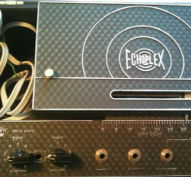This is a Guest Post by Guitarist, Jason Rooney
 On the long and winding road that is the pursuit of tone, it’s not long before we arrive at the Echoplex. We have no doubt read about tape delays, dreamt about them, but have definitely heard them on countless recordings. The EP3 Echoplex is the second generation in the Echoplex line and the first to offer a solid state preamp. The EP3 is an analog delay that does something I’ve found only tape can provide. Like many analog delays, the repeated notes continually degrade and ultimately taper off in a musical and natural way. However, the Echoplex does something very special with the repeated notes. The entire sonic space comes alive without stepping on the original notes. The echoed notes grow into a 3D atmosphere behind the performance that become slightly compressed with hints of a bright and chimey chorusing effect.
On the long and winding road that is the pursuit of tone, it’s not long before we arrive at the Echoplex. We have no doubt read about tape delays, dreamt about them, but have definitely heard them on countless recordings. The EP3 Echoplex is the second generation in the Echoplex line and the first to offer a solid state preamp. The EP3 is an analog delay that does something I’ve found only tape can provide. Like many analog delays, the repeated notes continually degrade and ultimately taper off in a musical and natural way. However, the Echoplex does something very special with the repeated notes. The entire sonic space comes alive without stepping on the original notes. The echoed notes grow into a 3D atmosphere behind the performance that become slightly compressed with hints of a bright and chimey chorusing effect.
The Echoplex is in no way a one trick pony, it can do it all. From a guitarist’s perspective, the EP3 can handle diligent slap back to dotted eighth notes inspired by The Edge. Vocals sound amazing through it, and many keyboard and synth enthusiasts swear by them as well. If you desire, you can send the delay oscillating and get some UFO sounds as well. And that is just in ‘echo mode’. The EP3 also offers a Sound on Sound feature that allows the user to take advantage of the Echoplex as a personal recorder and playback device. You can record a performance onto the tape and play it back to play over it. Somewhat of a looping feature only limited to the length of the tape in the cartridge.
The control panel of the Echoplex may seem a little menacing at first, but the controls are very standard to the delay world;
Echo Sustain: This controls the amount of delayed notes and also serves as the power switch.
Echo Volume: The volume of the delayed notes.
Echo Delay: A slider bar that controls the delay time by moving the playback head closer or farther away from the recording head.
Sound on Sound/Echo switch: This toggles between echo and sound on sound modes.
There are four 1⁄4” jacks on the face of the unit as well. Input, output, a footswitch jack to switch the delay on and off, and one to turn the sound on sound feature on and off.
When it comes to gear, especially vintage, we must factor in maintenance and a little bit of TLC. After all, the EP3 is a machine with moving parts that need to be cleaned and oiled. The tapes will eventually wear out, the sound gets increasingly wobblier, and the repeats become less strong. When it comes to tape replacement, cartridges are still available through a few sources as well as tape rewinding services. As the tape wears, it leaves a magnetic footprint and a brown dust behind. About the time the tape needs to be replaced, it’s a good idea to demagnetize and clean the tape heads, tape path and roller with either 100% denatured alcohol and a high quality rubber cleaner, or specific cleaners available for tape machines.
I must admit, I have received some strange looks and many questions when I’ve toted my EP3 to a gig or rehearsal. After all, it is somewhat of a clunky “mystery box” weighing 15lbs and requires a fair amount of real estate. After the EP3 has been set up and I start playing through it, The heavenly sound speaks for itself.

 Pedals & Effects
Pedals & Effects